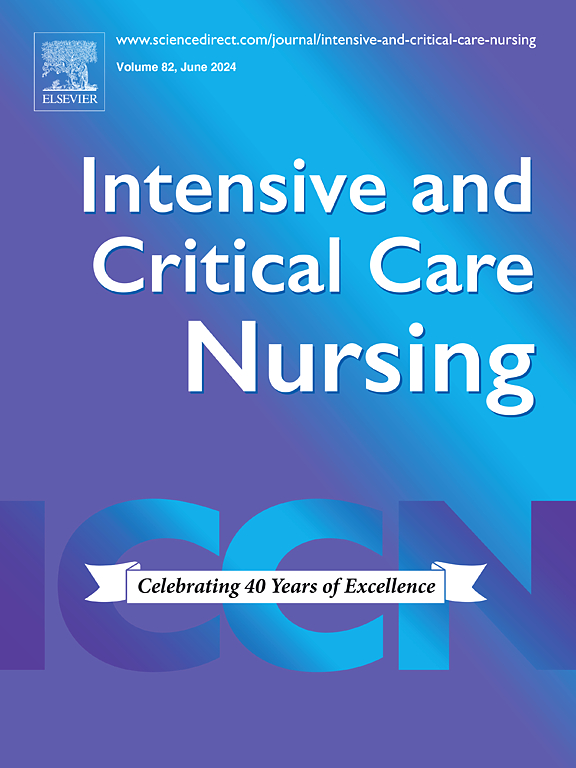家庭提供者沟通干预对ICU家庭心理健康、沟通质量和医疗保健利用的有效性:随机对照试验的系统回顾和荟萃分析
IF 4.7
2区 医学
Q1 NURSING
引用次数: 0
摘要
目的本综述旨在评估家庭提供者沟通干预的有效性。方法检索PubMed、PsycINFO、Web of Science、EMBASE、CINAHL和Cochrane Library 6个数据库。两名研究人员独立提取数据并评估偏倚。使用Stata软件和Review Manager对数据进行分析。结果共纳入19项研究。沟通干预对家庭需求的影响中等(SMD = - 0.43, 95% CI: - 0.81至- 0.06,P = 0.025),对6个月心理困扰的影响较小(总体:SMD = - 0.14, 95% CI: - 0.34至- 0.04,P = 0.04;焦虑:SMD = - 0.16, 95% CI: - 0.28 ~ - 0.05, P = 0.004),症状患病率降低(焦虑:RR = 0.78, 95% CI: 0.65 ~ 0.94, P = 0.009;抑郁症:RR = 0.79, 95%置信区间CI: 0.65 - -0.97, P = 0.022;创伤后应激障碍:RR = 0.70, 95%置信区间CI: 0.53 - -0.94, P = 0.015),减少小ICU停留(SMD =−0.10,95%置信区间CI: 0.20−−0.01,P = 0.036)。面对面(FTF)与印刷品补充对家庭需求有中等影响(SMD = - 0.53, 95% CI: - 0.69至- 0.36,P <;0.001),对3个月焦虑的影响较小(RR = 0.59, 95% CI: 0.44 ~ 0.79, P <;0.001)和抑郁发生率(RR = 0.62, 95% CI: 0.44 ~ 0.89, P = 0.009)。相反,有数字补充的FTF对通信质量(SMD = 0.28, 95% CI: 0.05-0.52, P = 0.01)、6个月的心理困扰(总体:SMD = - 0.19, 95% CI: - 0.34至- 0.04,P = 0.01;焦虑:SMD =−0.22,95%置信区间CI: 0.34−−0.10,P & lt;0.001;抑郁症:SMD =−0.17,95%置信区间CI: 0.29−−0.04,P = 0.007;创伤后应激障碍:SMD =−0.18,95%置信区间CI: 0.34−−0.02,P = 0.03)。结论家庭提供者沟通干预可有效改善家庭需求和沟通质量,提高长期心理结局,减少ICU住院时间。印刷材料在即时信息传递和缓解急性痛苦方面表现优异,而数字通信工具在持续沟通和长期痛苦管理方面表现优异。值得注意的是,尽管护士承担着多方面的沟通角色,但仍然缺乏关于其干预有效性的有力证据。对临床实践的启示icu提供者应考虑利用印刷材料进行即时信息传递,并利用数字工具进行持续的心理支持。未来的研究必须验证护士的沟通角色,并制定优化的策略来增强这些干预措施,以充分利用护士的专业知识。本文章由计算机程序翻译,如有差异,请以英文原文为准。
Effectiveness of family-provider communication interventions on family’s psychological health, communication quality, and health care utilization in the ICU: A systematic review and meta-analysis of randomized controlled trials
Objective
This review aims to assess evidence regarding the effectiveness of family-provider communication interventions.
Methods
We searched six databases (PubMed, PsycINFO, Web of Science, EMBASE, CINAHL and the Cochrane Library). Two researchers independently extracted data and assessed bias. Data were analyzed using Stata software and Review Manager.
Results
Nineteen studies were included. Communication interventions had a moderate effect on family needs (SMD = −0.43, 95 % CI: −0.81 to −0.06, P = 0.025), small effects on 6-month psychological distress (Overall: SMD = −0.14, 95 % CI: −0.34 to −0.04, P = 0.04; Anxiety: SMD = −0.16, 95 % CI: −0.28 to −0.05, P = 0.004), and reduced symptom prevalence (Anxiety: RR = 0.78, 95 % CI: 0.65–0.94, P = 0.009; Depression: RR = 0.79, 95 % CI: 0.65–0.97, P = 0.022; PTSD: RR = 0.70, 95 % CI: 0.53–0.94, P = 0.015), with a small ICU stay reduction (SMD = −0.10, 95 % CI: −0.20 to −0.01, P = 0.036). Face-to-face (FTF) with print supplements had a moderate effect on family needs (SMD = −0.53, 95 % CI: −0.69 to −0.36, P < 0.001), small effects on 3-month anxiety (RR = 0.59, 95 % CI: 0.44 to 0.79, P < 0.001) and depression incidence (RR = 0.62, 95 % CI: 0.44 to 0.89, P = 0.009). Conversely, FTF with digital supplements yielded small effects on communication quality (SMD = 0.28, 95 % CI: 0.05–0.52, P = 0.01), 6-month psychological distress (Overall: SMD = −0.19, 95 % CI: −0.34 to −0.04, P = 0.01; Anxiety: SMD = −0.22, 95 % CI: −0.34 to −0.10, P < 0.001; Depression: SMD = −0.17, 95 % CI: −0.29 to −0.04, P = 0.007; PTSD: SMD = −0.18, 95 % CI: −0.34 to −0.02, P = 0.03).
Conclusion
Family-provider communication interventions effectively improve family needs and communication quality, enhance long-term psychological outcomes, and reduce ICU stays. Print materials excelled in immediate information delivery and acute distress alleviation, while digital communication tools were superior for sustained communication and long-term distress management. Notably, despite nurses assuming multifaceted communication roles, robust evidence for their intervention effectiveness remains lacking.
Implications for clinical practice
ICU providers should consider utilizing print materials for immediate information delivery and digital tools for ongoing psychological support. Future studies must validate nurses’ communication roles and develop optimized strategies to enhance these interventions to fully leverage nurses’ professional expertise.
求助全文
通过发布文献求助,成功后即可免费获取论文全文。
去求助
来源期刊

Intensive and Critical Care Nursing
NURSING-
CiteScore
6.30
自引率
15.10%
发文量
144
审稿时长
57 days
期刊介绍:
The aims of Intensive and Critical Care Nursing are to promote excellence of care of critically ill patients by specialist nurses and their professional colleagues; to provide an international and interdisciplinary forum for the publication, dissemination and exchange of research findings, experience and ideas; to develop and enhance the knowledge, skills, attitudes and creative thinking essential to good critical care nursing practice. The journal publishes reviews, updates and feature articles in addition to original papers and significant preliminary communications. Articles may deal with any part of practice including relevant clinical, research, educational, psychological and technological aspects.
 求助内容:
求助内容: 应助结果提醒方式:
应助结果提醒方式:


